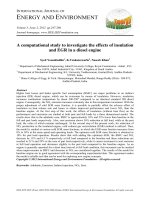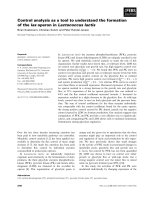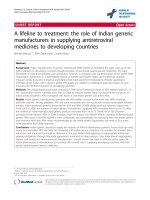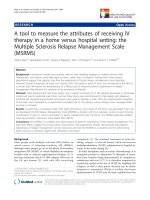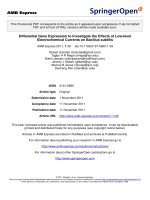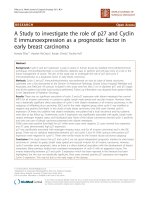A study to investigate the involvement of nadph oxidase 5 (NOX5) in resveratrol (RSV) induced reactive oxygen species (ROS) production in u937 cells
Bạn đang xem bản rút gọn của tài liệu. Xem và tải ngay bản đầy đủ của tài liệu tại đây (4.84 MB, 110 trang )
A STUDY TO INVESTIGATE THE INVOLVEMENT OF
NADPH OXIDASE 5 (NOX5) IN RESVERATROL (RSV) - INDUCED
REACTIVE OXYGEN SPECIES (ROS)
PRODUCTION IN U937 CELLS
BHUVANESHWARI D/O SHUNMUGANATHAN
[BSc (Hons), NTU]
A THESIS SUBMITTED
FOR THE DEGREE OF MASTER OF SCIENCE
DEPARTMENT OF PHYSIOLOGY,
YONG LOO LIN SCHOOL OF MEDICINE
NATIONAL UNIVERSITY OF SINGAPORE
2010
ACKNOWLEDGEMENTS
Firstly I would like to express my gratitude to Dr Andrea Lisa Holme for her unwavering
guidance and support throughout the course of my Masters project as my supervisor and her
help with assays involving the LSC. I would also like to thank Professor Shazib Pervaiz for
his invaluable advice and input in this project as my co-supervisor.
My heartfelt gratitude also goes out to Dr Alan Premkumar and his students, Ms Hay Hui Sin,
Ms Chen Luxi, Ms Loo Ser Yue and Ms Angele Koh. They have always provided with
unconditional moral support during the ups and downs of my graduate studies. The time
spent together will always be cherished.
I would also like to express my sincere appreciation to all members of the ROS ,apoptosis
and cancer biology lab for accommodating me as a ‘surrogate/adpoted’ member of their lab.
In this 2 ½ years I have not only enhanced my knowledge on scientific research but have also
built friendships through my interaction with the people from this lab.
My sincere appreciation also goes out to the admin staff from the department of Physiology
and also Cancer science institute (CSI), NUS for the use of their premises during the last half
year.
Finally, but most importantly I would like to thank my family for being a strong pillar of
support and above all God for guiding and bringing me through this phase of my life
successfully.
TABLE OF CONTENTS
ABSTRACT i
LIST OF TABLES ii
LIST OF FIGURES iii
ABBREVIATIONS USED vi
1. INTRODUCTION
1.1: (a) Reactive oxygen species (ROS) 1
(b) ROS as signaling molecules 3
(i) Cell signaling fate resulting from the alteration of cellular redox status
(ii) The antioxidant enzyme systems as a means of maintaining homeostatic
cellular redox balance
1.2: NADPH Oxidases (NOX)
(i) Overview 7
(ii) Sub-cellular localization of NOX enzymes 10
(iii) Physiological/ pathological functions of NOX enzymes generated ROS 13
1.3: NADPH Oxidase 5 (NOX5) 19
1.4: Resveratrol (RSV)
(i) Chemical structure and biological properties 24
(ii) Modulation of cellular function 25
(iii) Modulation of cellular redox status 26
(iv) Autophagy and metabolism
(v) RSV and Reactive oxygen species (ROS)/NADPH Oxidase (NOX)
1.5: Aim of study 29
1.6: Mode of action of the classes of compounds used in the study…………………………29
2. MATERIALS AND METHODS
2.1: Materials/Reagents 30
2.2: Methods/Protocols/Plan of investigation 31
3. RESULTS
3.1: Resveratrol exerts dose-dependent cellular physiological effects in U937 39
a) MTT cell viability assay 40
b) Cell cycle analysis 42
3.2: Establishing working doses for treatment of U937 with ROS-producing compounds, ROS
scavengers and NOX inhibitor via Cell viability MTT assay 44
3.3: Resveratrol increases NOX5 expression level in U937 50
3.4: Resveratrol produces ROS in U937 55
3.5: Scavenging of ROS produced by RSV abrogates the increase in NOX5 expression 57
ROS regulation of NOX5 expression
3.6: (i) The treatment of U937 with DDC shows a dose-dependent increase in NOX5
expression level 63
(ii) The treatment of U937 with hydrogen peroxide shows a dose-dependent increase in
NOX5 expression level 65
(iii) a) The treatment of U937 with nitric oxide producing compounds such as SIN-1
chloride and DETA-NO do not significantly alter NOX5 expression levels 66
b) NO producing compounds cause phosphorylation of c-Raf (positive control) 67
3.7: Resveratrol treatment results in the phosphorylation of CREB at early time points 68
3.8: Cyclosporin A inhibits CREB phosphorylation and abrogates the increase in NOX5
expression level following Resveratrol treatment 70
4. DISCUSSION/CONCLUSIONS/ FUTURE WORK
4.1: Overview on study 74
4.2: Resveratrol exerts several physiological effects in dose-dependent manner 75
4.3: Reseveratrol increases NOX5 expression level in U93 75
4.4: i) Resveratrol produces ROS 77
ii) The scavenging of ROS abrogates the increase in NOX5 expression level 77
4.5: i) ROS producing compounds such as DDC and Hydrogen Peroxide (H
2
O
2
) cause an
increase in NOX5 expression 77
ii) ROS scavenging abrogates the increase in NOX5 expression 78
4.6: i) RSV treatment results in the phosphorylation of CREB 78
ii) The inhibition of CREB phosphorylation via pre-treatment with Cyclosporin
abrogates the increase in NOX5 expression level 79
4.7: Conclusion 79
4.8: Future work 81
5. REFERENCES 83
6. SUPPLEMENTARY FIGURES 90
i
I. ABSTRACT
ROS are oxygen - derived small molecules. The initial form of ROS is superoxide anion (O
2
) which is produced by the gain of electrons. Subsequent chemical reactions can lead to the
formation of other forms of ROS species. NOX enzymes are one of the major sources of
ROS. NOX5 belongs to the family of NOX enzymes. NOX5 differs from the other members
of the NOX family in aspects as such as its mode of activation and biophysical structure.
NOX5 comprises of 2 membrane-bound subunits namely gp91 and p22. It does not require
the recruitment of cytosolic subunits, unlike its counterparts. The activity of NOX5 is
regulated by elevations in cytosolic calcium levels and phosphorylation via kinases such as c-
Abl (Abelson murine leukemia viral oncogene) and PKC. The N-terminus of NOX5
comprises EF-hands that serve as calcium binding domains. It has been established so far that
NOX5 is a growth signalling oxidase and its expression is regulated via growth regulatory
agonists/triggers/signals. NOX5 has been also shown to be expressed in a variety of tumour
cell lines and is being explored as a cancer biomarker. RSV a naturally occurring phenolic
phytoalexin is currently being employed as a ‘parent’ compound in cancer drug development.
It has been well-studied that RSV is a ROS-modulating compound. It can act as a pro/anti-
oxidant depending on the concentration and cell line used. Previous studies have shown that,
RSV is able to alter the expression and activity of other NOX isoforms is a range of cell lines.
This study aimed to investigate the involvement of RSV-induced ROS production in
regulating NOX5 expression in the U937 lymphoma cells. The initial part of the study
involved analyzing the expression of NOX5 following RSV treatment. RSV was shown to
increase NOX5 expression in U937 in a dose-dependent manner. A time course was also
performed and it showed that NOX5 expression starts to increase as early as 2hr. ROS was
being implicated as the possible factor involved in the regulation of NOX5 expression due to
the nature of RSV. The pre-treatment of U937 with ROS scavengers prior to RSV treatment
abrogated the increase in NOX5 expression. Further studies were performed and it showed
ROS producing compounds such as DDC and H
2
O
2
were able to increase NOX5 expression
level. However, NO-producing compounds did not significantly alter the NOX5 expression
level. CREB phosphorylation was observed post-RSV treatment and this was reversible via
pre-incubation with Cyclosporin A. CREB phosphorylation levels were also observed to
precede the increase NOX5 expression level. Thus CREB is being suggested as a possible
transcription factor regulating NOX5 expression. This study highlights the role of ROS
producing compound RSV in regulating the expression level of NOX5 in U937. (442 words)
ii
II. LIST OF TABLES
TABLE 1: A summary highlighting the cellular distribution, subcellular localization and the
major physiological function of the NOX isoforms
TABLE 2: Gene expression level of NOX 1-5, DUOX 1 and DUOX2 relative to
18s rRNA expression (x10-8) in tumor cell lines
iii
III. LIST OF FIGURES
INTRODUCTION
FIGURE 1: The main biochemical reactions involved in the formation of Reactive oxygen
species (ROS)
FIGURE 2: Diagram illustrating the importance of cellular homeostatic redox balance
FIGURE 3: The intracellular sources of ROS. The subcellular compartmentalization of ROS
FIGURE 4: Pylogeny tree of the NOX family
FIGURE 5: Schematic representation of NOX2 enzyme activation
FIGURE 6: Schematic representation of the various mechanisms of activation. The
cofactors/subunits required for the activation are highlighted. Diagrammatic representation of
the transmembrane topology and domains of the NOX isoform
FIGURE 7: Schematic representation of NADPH Oxidase 5 (NOX5)
FIGURE 8: A diagram representing the current research development on NOX5
FIGURE 9: Chemical structure of Resveratrol
RESULTS
FIGURE 1a: Cell viability assay of U937 in response to RSV treatment
FIGURE 1b:
FIGURE 1c: PI live cell cycle analysis assay of U937 cells following the indicated doses of
RSV
FIGURE 1d: Cellular morphology of cells for 24hrs with increasing doses of RSV and
scanned at 0.25μM step size at 40x objective representative field images
FIGURE 2a: Cell viability assay of U937 in response to tiron treatment
FIGURE 2b: Cell viability assay of U937 in response to catalase treatment
FIGURE 2c: Cell viability assay of U937 in response to NAC treatment
FIGURE 2d: Cell viability assay of U937 in response to DPI treatment
iv
FIGURE 2e: Cell viability assay of U937 in response to DDC treatment
FIGURE 2f: Cell viability assay of U937 in response to H
2
O
2
treatment
FIGURE 2g: Cell viability assay of U937 in response to SIN-1 Chloride treatment
FIGURE 2h: Cell viability assay of U937 in response to DETA-NO treatment
FIGURE 3: Analysis of NOX5 expression following 24hr RSV treatment
FIGURE 4: Basal expression level of NOX5 in untreated U937 cells
FIGURE 5: A time coure study of NOX5 expression in U937 following 25μM RSV treatment
FIGURE 6: Analysis of NOX5 expression following 3hr RSV treatment
FIGURE 7a: ROS production in U937 cells DCFDA assay was performed to measure the
level of ROS produced following RSV treatment. The percentage of cells in R2 region is a
measure of fluorescence intensity
FIGURE 7b: Pre-incubation of U937 with ROS scavengers and NOX inhibitor DPI abrogates
the increase in NOX5 expression following 25μM RSV treatment
FIGURE 8: RSV treatment does not significantly alter the antioxidant enzyme levels
FIGURE 9: DDC treatment increaseS NOX5 expression in U937 cells
FIGURE 10: Pre-incubation with Tiron abrogates the increase in NOX5 expression via DDC
treatment
FIGURE 11: H
2
O
2
treatment increases NOX5 expression in U937
FIGURE 12: Pre-incubation with Catalase abrogates the increase in NOX5 expression via
H
2
O
2
treatment
FIGURE 13: Nitric oxide producing compounds such as SIN-1 chloride and DETA-NO do
not significantly change the expression level of NOX5
FIGURE 14: RSV treatment results in the phosphorylation of CREB in a time-dependent
manner.
FIGURE 15: Pre-treatment of Cyclosporin A inhibits the phosphorylation of CREB and
abrogates the increase in NOX5 expression observed via RSV treatment
v
DISCUSSION
Figure 1: Diagram representing the summary of the study
SUPPLEMENTARY FIGURES
FIGURE 1a: PI cell cycle analysis of U937 cells following 12hr of RSV treatment
FIGURE 1b: PI cell cycle analysis of U937 cells following 24hr of RSV treatment
FIGURE 2a: DCFDA assay analyzing ROS production following 30 minutes of RSV
treatment in U937 cells
FIGURE 2b: DCFDA assay analyzing ROS production following 1hr of RSV treatment in
U937 cells
FIGURE 2c: DCFDA assay analyzing ROS production following 12hr of RSV treatment in
U937 cells
FIGURE 3a: DDC produces ROS
FIGURE 3b: The ROS produced by DDC can be scavenged by tiron
FIGURE 4a: H
2
O
2
produces ROS
FIGURE 4b: ROS produced by H2O2 can be scavenged by catalase
vi
IV. ABBREVIATIONS USED
AMPK 5’ Adenosine monohosphate – activated protein kinase
AngII Angiotensin II
AP-1 Activator protein
Bax Bcl-2 associated X protein
BSA Bovine Serum albumin
c-Abl Abelson murine leukaemia viral oncogene homolog 1
CaM Calmodulin
cAMP Cyclic adenosine monophosphate
Cdc42 Cell division cycle 42
cGMP Cyclic guanosine monophosphate
COX-2 Cyclooxygenase-2
c P LA
2
Cytosolic phospholipase 2
CREB cAMP response element binding protein
c-Src Cellular sarcoma
Cu/ZnSOD Copper/Zinc Superoxide dismustase
DCFDA 2´-7´-dichlorofluorescin diacetate
DDC Diethyldithiocarbamate
DMSO Dimethyl sulfoxide
DNA Deoxyribonucleic acid
DPI Diphenyliodonium
DTT Dithiothreitol
DUOX Dual oxidase
vii
EA Esophageal adenocarcinoma
EC Endothelial cell
Egr Early growth response
ER Endoplasmic reticulum
Erk kinase Extracellular signal-regulated kinase
ET-1 Endothelin-1
Ets-1 v-ets erythroblastosis virus E26 oncogene homolog 1 (avian)
Fas Tumor necrosis factor (TNF) receptor superfamily, member 6
FOXO Forkhead box O subclass
H
2
O
2
Hydrogen peroxide
HASMC Human aortic smooth muscle cell
IC AM-1 Inter-cellular adhesion molecule 1
JAK Janus kinase
JNK c-Jun N-terminal kinases
LPS Lipopolysaccharide
MAPK Mitogen-activated protein kinase
MMP Metallomatrix proteinase
MnSOD Manganese Superoxide dismutase
mRNA Messenger Ribonucleic acid
mTOR Mammalian target of rapamycin
NAC N-acetyl cysteine
NAD+ Nicotinamide adenine dinucleotide (Oxidized form)
NADH Nicotinamide adenine dinucleotide (reduced form)
viii
NADP+ Nicotinamide adenine dinucleotide phosphate (Oxidized form)
NADPH Nicotinamide adenine dinucleotide phosphate (Reduced form)
NF-κB Nuclear factor kappa-light-chain-enhancer of activated B cells
NOX NADPH Oxidase
NOX5-S NADPH Oxidase 5 Short isoform
Nrf2 Nuclear factor (erythroid-derived 2)-like 2
P53 Protein 53
PDGF Platelet derived growth factor
PI Propidium iodide
PI3K Phosphoinositide 3-kinase
PKC Protein Kinase C
Rac Ras related C3 botulinum toxin substrate
Ras Rat sarcoma
Rb Retinobalstoma
RhoA Ras homolog gene family, member A
RIP 1 Receptor interacting protein-1
RIPA Radioimmunoprecipation
ROS Reactive oxygen species
RSV Resveratrol
RT-PCR Reverse-transcription - Polymerase chain reaction
SAPK Stress-activated protein kinase
SDS Sodium dodecyl sulphate
SDS-PAGE SDS-Polyacrylamide gel electrophoresis
ix
SHP-1 Src homology region 2 domain-containing phosphatase
SIRT Sirtuin
SP-1 Specificity protein 1
Src Sarcoma
STAT Signal transducer and activator of transcription
TLR Toll-like receptor
TNF Tumor necrosis factor
TNFR TNF receptor
TRADD TNF receptor type 1- associated DEATH domain protein
VCAM-1 Vascular cell adhesion molecule 1
VEGF Vascular endothelial growth factor
VSMC Vascular smooth muscle cells
Introduction
1. INTRODUCTION
1.1 (a): Reactive oxygen species (ROS)
Oxygen is one of the most abundant gases in the atmosphere and is the principle
component in air. Dry air contains roughly (by volume) 78.09% nitrogen, 20.95%
oxygen, 0.93% argon, 0.039% carbon dioxide, and small amounts of other gases. Air also
contains a variable amount of water vapor (an average of 1%). Reactive oxygen species
(ROS) are oxygen-derived small molecules (Bedard and Krause, 2007). These comprise
of free radicals (i.e., species with ≥ 1 unpaired electrons) such as superoxide anion (O
2
),
peroxynitrite (ONOO
-
), hydroxyl (OH
-
), peroxyl (RO
2
-
) and alkoxyl (RO
-
) and some non-
radical species such as hydrogen peroxide (H
2
O
2
), ozone (O
3
) and hypochlorous acid
(HOCl)(Lambeth, 2004). ROS has been under intense investigation for its role in cellular
‘Oxidative stress’. ‘Oxidative stress’ is best described as the imbalance between oxidants
and antioxidants, in favor of oxidants, potentially leading to damage (Sies, 1991).
Interestingly, the various ROS species differ in their reactivity with O
2
and H
2
O
2
being
weaker and displaying limited bioreactivity in comparison to ONOO
-
, OH
-
and HOCl
(Halliwell, 2006). These species can be grouped according to their redox potentials at pH
7. Most ROS reactions are not based on electron transfer but rather proton coupled
electron transfer (PCET) e.g., conversion of H
2
O
2
to O
2
and H
2
O. ROS generation begins
with the generation of O
2
. O
2
is a short-lived molecule and undergoes spontaneous
dismutation to O
2
and H
2
O
2
at the rate of 10
5
M
-1
S
-1
at pH7. It can also be rapidly
converted to other forms of ROS; 1) O
2
can be converted to OH
-
by the Fenton reaction,
2) react with nitric oxide (NO) to form ONOO
-
3) form H
2
O
2
in a reaction generally
catalysed by superoxide dismutase (SOD) (D'Autréaux and Toledano, 2007). The essence
of these biochemical processes involving the progressive formation of ROS from O
2
is
illustrated in Figure 2.
1
Introduction
V
Figure 1: The main biochemical reactions involved in the formation of ROS.
The diagram illustrates the progressive formation of the various ROS species with O
2
as the initial
specie formed. The redox potentials of each ROS forming stage are also highlighted
Adapted from: D’Autréaux and Michel B. Toledano
Nature Reviews, Molecular Cell Biology 2007
ROS are produced in response to growth factors, cytokines, G protein-coupled receptor
agonists, or shear stress and have been well-characterized to mediate various responses
including cell proliferation, migration, differentiation and gene expression (Bedard and
Krause, 2007; Brown and Griendling, 2009). A number of studies have shown that ROS
has both positive and detrimental impacts in cellular physiology. This is as, ROS can
react with cellular components such as lipids, proteins and nucleic acids. As stated
previously, an imbalance in the redox status of the cell leads to the physiological
condition termed, ‘oxidative stress’. This condition has been linked to be involved in a
number of disease states such as Alzheimer’s, arthritis and cancer due to the disruption of
cell death and proliferation mechanisms (Azad et al., 2008; Halliwell, 2007; Pervaiz and
Clement, 2007).
In the cell, there are a number of enzyme-based systems that generate ROS, NADPH
oxidase (NOX) is the one of the major enzymes involved in cellular ROS production
2
Introduction
(Bedard and Krause, 2007; Lambeth et al., 2007). The mitochondrial electron transport
chain is another abundant source of ROS. The mitochondrial electron transport chain
comprises of a chain of enzymes. Due to the electron leakage that occurs along the
electron transport chain during these redox reactions, O
2
is generated. The other enzyme
systems involved are xanthine oxidase, cyclooxygenase, lipooxygenase, cytochrome
P450s, NOS (nitric oxide synthase) enzymes, other hemoproteins (Cai et al., 2003;
Halliwell, 2007) as well as a number of antioxidant systems that protect the cell from
potentially harmful effects such as the catalase, SODs and glutathione (GSH) system. The
next section discusses the role of ROS as signaling molecules and the importance of a
homeostatic redox environment in the cell.
1.1(b) ROS as signaling molecules
(i) Cell signaling fate resulting from the alteration of cellular redox status
Current studies have well-established that a shift in the balance of ROS species present
alters the signaling fate of the cell (Brown and Griendling, 2009; D'Autréaux and
Toledano, 2007; Pervaiz and Clement, 2007). In the context of tumor biology it has been
shown that an increase in the level of O
2
in comparison to H
2
O
2
levels, promotes
proliferation/survival and activation of cell survival signaling (Pervaiz and Clement,
2007). However in contrast, when H
2
O
2
levels are high relative to superoxide levels, cell
death signaling pathways predominate in the cell (Pervaiz and Clement, 2007). More
specifically, millimolar concentrations of H
2
O
2
result in necrotic cell death whereas
micromolar concentrations of more than 80-100 seem to predominantly activate apoptotic
signaling pathways. This elegant model is well illustrated in Figure 2 and it highlights the
importance of maintaining a homeostatic cellular redox environment.
3
Introduction
(ii) The antioxidant enzyme systems as a means of maintaining homeostatic cellular
redox balance.
As stated in the previous section, ROS is a product of normal cellular metabolism. The
redox state of a cell is maintained and determined by the levels of pro-oxidant species
like ROS and presence of antioxidant systems (Halliwell, 2007; Pervaiz and Clement,
2007). Some of the antioxidant systems present are SOD 1-3 (Superoxide dismutases),
Catalase, Thioredoxins/Peroxiredoxins and Glutathione peroxidase/reductase (Halliwell,
2006). These antioxidant systems function as cellular protective mechanisms and provide
the first line of defense against ROS.
Superoxide dismutases (SODs) are involved in the scavenging of O
2
. SODs catalyze the
conversion of superoxide anions into H
2
O
2
and O
2
. The different forms of SODs vary in
terms of their sub-cellular localization and the metal group present at the catalytic active
site. SOD 1 or Cu/ZnSOD (Copper/Zinc SOD) is found in the cytosol and contains
Copper and Zinc metal ions in the active site. SOD 2 commonly referred to as MnSOD
(Manganese SOD) is localized in the mitochondria and its catalytic active site contains
Manganese ion. SOD 3 is known as the extracellular SOD and contains copper and zinc
at the active site. In relation to cancer development, MnSOD is of specific interest in
comparison to the other SODs. MnSOD has been found to be downregulated in certain
tumor types (Valko et al., 2007). It has been studied that overexpression or increased
activity of MnSOD leads to a decrease in the O
2
levels and subsequent suppression of
cell growth in cancer lines (Valko et al., 2007).
Catalase serves as the enzyme essential in the removal of H
2
O
2
via its catalytic
conversion into water and oxygen. The basic structure of catalase is a tetramer made up
of 4 polypeptide chains. Each polypeptide contains a porphyrin heme group at the
catalytic site involved in the reaction with hydrogen peroxide.
Glutathione peroxidases (GPx) are a group of selenium-containing enzymes involved in
the removal of H
2
O
2
via the coupling of its reduction to the oxidation of glutathione
(GSH). GSH is a thiol-containing tripeptide. The oxidized form of glutathione, GSSG is
4
Introduction
made up of 2 GSH molecules linked by a disulphide bridge. GSSG can be converted to
the reduced form GSH, via the action of glutathione reductases. Glutathione functions as
an antioxidant molecule by protecting the cells against oxidative stress (Valko et al.,
2007). It performs this significant role by; 1. It regenerates most antioxidant enzymes
such as Vitamin E and C, 2. GSH scavenges OH
-
and detoxifies H
2
O
2
, 3. It is present as a
cofactor of several detoxifying enzymes such as GPx and 4. It participates in amino acid
transport through the plasma membrane protecting them from oxidation.
Peroxiredoxins (PrX) form another another group of enzymes that are involved in the
decomposition of H
2
O
2
. PrXs are homodimers that contain cysteine (Cys) at their active
groups. H
2
O
2
oxidizes the SH group on PrX to form sulfeinc acid (Cys-SOH) and itself
will be reduced to H
2
O and O
2
. The diagram in Figure 3 summarizes the intracellular
sources of ROS and the various cellular antioxidant defense systems present.
As mentioned previously, the NOX family of enzymes, function as one of the major
contributing sources of ROS. This literature summarizes their activity and physiological
function in relationship to cellular ROS status.
5
Introduction
Figure 2: Diagram illustrating the importance of cellular homeostatic redox balance
The diagram highlights the concept that O
2
functions as a tumor-promoting ROS and H
2
O
2
plays the
converse role and promotes cell death. Thus a balance in the 2 types of ROS is essential in maintaining
normal cellular function.
Adapted from: Pervaiz, Clement, Int. J. Biochem & Cell biology 2007
Figure 3: The intracellular sources of ROS
The subcellular compartmentalization of ROS
Adapted from: Trachootham et.al
Nature reviews Drug discovery 2009
6
Introduction
1.2: NADPH Oxidases
(i) Overview
NADPH Oxidases or NOXs, are enzymes whose principal biological function is the
production of the O
2
species (Bedard and Krause, 2007; Lambeth et al., 2007; Lambeth
et al., 2008). This takes place via electron transfer during the reduction of NADP
+
to
NADPH. The electron transfer to molecular oxygen (O
2
) results in the generation of O
2
(Bedard and Krause, 2007; Lambeth, 2004). The NOX family of enzymes primarily
consists of 7 members; NOX 1-5 and DUOX 1/2 (Bedard and Krause, 2007). Figure 4
illustrates the phylogeny tree of the NOX family.
Figure 4: Phylogeny tree of the NOX family.
Adapted from:
The family now consists of 7 members in human, with orthologs in mouse, rat, Drosophila and C.
elegans. A family tree constructed by comparing the sequences of the gp91phox-homology domain
reveals three subfamilies: a gp91phox-like group, a Duox group, and a more distant homolog
consisting of a single member, Nox5.
In this family, NADPH Oxidase 2 (NOX2) or previously referred to as phagocytic NOX
was the first isoform discovered and was studied in immune cells in relationship to host
defense (Bedard and Krause, 2007; Lambeth, 2004; Lambeth et al., 2007). Due to this
discovery ROS was initially perceived as detrimental as it was shown to be involved in
the killing of microbial organisms. This is characterized by an over-generation of ROS
also known as ‘respiratory burst’, in response to pathogen invasion (Poolman et al.,
2005). The excessive ROS levels are then directly involved in the ‘killing’ process by
damaging cellular structures and/or indirectly involved via activating release of cytokines
and pro-inflammatory signaling pathways (Maloney et al., 2009; Poolman et al., 2005).
7
Introduction
The diagram in Figure 6 below illustrates that the mechanism of NOX activation can be
classified into 2 subtypes: the classical NOX enzymes (NOX 1-3) that require the
assembly of subunits and non-classical NOX enzymes (NOX4-5 and DUOX1/2) that can
be activated without the assembly of cytosolic subunits. The classical NOX isoform is a
6- alpha helice transmembrane protein. It is made up of 2 membrane-bound subunits;
gp91 (catalytic) and gp22 (regulatory) and 3 cytosolic subunits p47, p67 and Rac
(Kawahara et al., 2007; Lambeth, 2004; Lambeth et al., 2007). The assembly of the
membrane-bound and cytosolic subunits, constitutes an active NOX enzyme (Figure 5).
The signal for this assembly typically begins with the phosphorylation of the cytosolic
p47 subunit, which leads to the translocation of p67 and Rac together with p47 to the
membrane bound subunits resulting in the assembly of an active NOX enzyme. Previous
studies have identified Protein kinase C (PKC) as one of the kinases involved in the
phosphorylation of the p47 subunit and positive regulation of NOX activity (El Benna et
al., 1996; Faust et al., 1995).
As mentioned earlier, the first NOX enzyme NOX2, was discovered in immune
phagocytic cells. Increasing evidence from subsequent studies showed that non-immune
cells also produce ROS. This was linked to the discovery of the other NOX isoforms
(Kawahara et al., 2007). Furthermore the levels of ROS produced were found to be not
excessive or physiologically detrimental. This created a paradigm shift where by NOX-
derived ROS also functions as an essential signaling molecules/ secondary messengers
(Bedard and Krause, 2007; Brown and Griendling, 2009).
Table 1 provides a summary highlighting the cellular distribution, subcellular localization
and physiological functions of the NOX isoforms. These will also be discussed in the
upcoming sections.
Having an overview of the biophysical characteristics of the NOX family the next section
deals with the subcellular localization of the various NOX enzymes.
8
Introduction
Figure 5: Schematic representation of
NOX2 enzyme activation.
Adapted from:
Berdard et.al, Physiology Reviews 2007
Figure 6: Schematic representation of the various mechanisms of activation. The
cofactors/subunits required for the activation are highlighted. Diagrammatic
representation of the transmembrane topology and domains of the NOX isoform
Adapted from:
Brown and Griendling et.al, Free radical biology and medicine 2009
9
Introduction
(ii) Subcellular localization of NOX enzymes
The subcellular localization of the different NOX family members varies between cell
lines. The localization of this enzyme appears to be crucial in determining
compartmentalized ROS generation and subsequent activation of redox signaling
pathways, which target redox-sensitive molecules within the space of the sub-cellular
compartment (Ushio-Fukai, 2006). These are described below.
Caveolae/Lipid rafts)
Many signaling molecules such as G protein-coupled receptors, death receptors, G-
proteins, receptor tyrosine kinase, Src family kinases and PKC are concentrated on
caveolae/lipid rafts microdomains (Ushio-Fukai, 2006). The close proximity/
compartmentalized localization of these molecules, is essential for efficient activation of
the downstream signal transduction events. The importance of NOX localization in
caveolae/lipid rafts has been highlighted in various studies. In vascular smooth muscle
cells (VSMCs), stimulation with angiotensin II (Ang II) results in the activation of AT1
receptor (AT1R) and its translocation to the caveolin-1 containing lipid raft domains (Cai
et al., 2003; Park et al., 2006). The activation of AT1 receptors promotes Rac1
translocation and subsequent assembly/activation of NOX1 into the lipid rafts leading to
increased localized ROS production. ROS production leads to activation of redox
signaling pathways that result in vascular hypertrophy and eventually may lead to
hypertension (Cai et al., 2003; Touyz and Schiffrin, 2004). Other signaling pathways are
as follows; 1. Activation of redox-sensitive transcription factors such as AP-1 and NF-κB
that contribute to inflammation, 2.The regulation of the activity and/or expression of
matrix metalloproteinases (MMPs) that leads to the remodeling of extracellular matrix
(ECM) and 3. The activation of ion channels such as Ca
2+
ion channels that result in
cellular migration and contraction (Touyz and Schiffrin, 2004). A multitude of these
factors eventually lead to the vascular inflammation, remodeling and altered vascular
tone. These play a vital role in the development of hypertension.
10
Introduction
Nucleus
The localized ROS production in the nucleus is involved in the regulation of redox-
sensitive transcription factors such as include SP-1, AP-1, NF-κB, p53 and Nrf2 (Ushio-
Fukai, 2006) . The activation of transcription factors leads to subsequent gene regulation,
activation of signaling pathways and physiological changes in the cell. In this aspect,
previous studies have shown that NOX localization in the nucleus to be crucial in cell
signaling. In VSMCs, NOX4 preferentially localizes to the nucleus (Lassègue and
Clempus, 2003). The nuclear localization has been studied to be involved in oxidative
stress response gene expression. Some of the target genes involved are as follows; 1) Cell
cycle proteins such as Cyclin D and p21 that are involved in regulating cell growth 2)
Pro-apoptotic proteins such as Bax, Fas and Noxa 3) Cytokines such as Interleukin-6( IL-
6), IL-1 and TNF-α and 4) Cell adhesion molecules such as VCAM-1 and ICAM-1
Endosomes
It has been suggested that NOX enzymes are found on internal membrane structures
(Ushio-Fukai, 2006). Some studies have reported NOX5 has to be localized not only on
the plasma membrane but also on perinuclear compartments such as the endoplasmic
reticulum (ER) (Jagnandan et al., 2007). NOX-dependent ROS production in endosomes
is involved in proinflammatory immune responses (Ushio-Fukai, 2006). A study by Li
et.al, highlighted that in VSMCs, the binding of Interleukin-1β (IL-β) to the IL -1
receptors (IL-1R) promoted the endocytosis of the receptors to the endosomes. This was
crucial for the simultaneous translocation of the plasma membrane-bound NOX2. NOX2-
derived ROS contributed to the subsequent activation of NF-κB.
Cell-matrix adhesions and cell-cell contact
Cell- matrix adhesions serve as focal points or junctions for the recruitment of signaling
proteins/molecules involved in redox-sensitive signaling pathways that promote cell
function (Ushio-Fukai, 2006). These junctions serve as centers for ‘cross-talk’ between
structural proteins such as the integrins and regulatory signaling molecules such as
tyrosine kinases and small G-proteins. The ROS-generated by NOX present in this
compartment serve as intermediate/secondary signaling molecules crucial for activating
11


